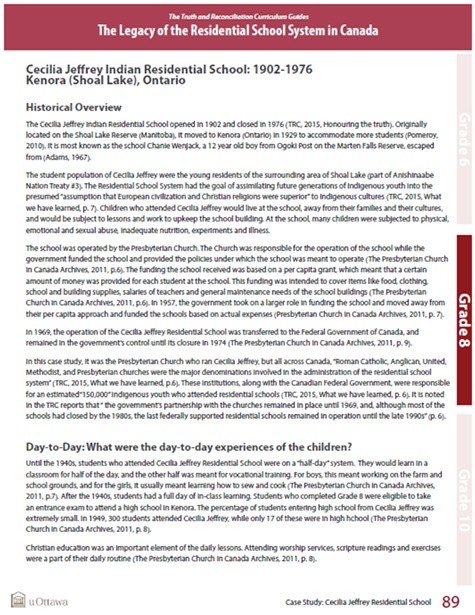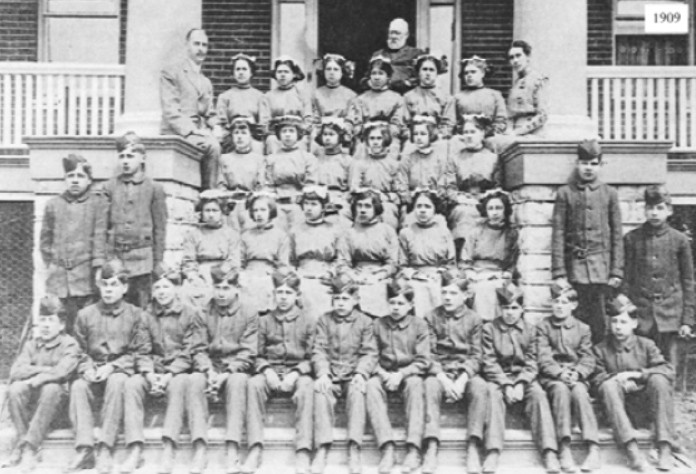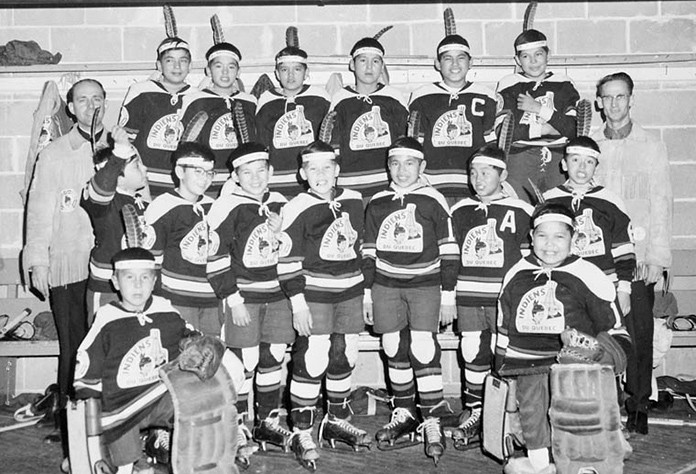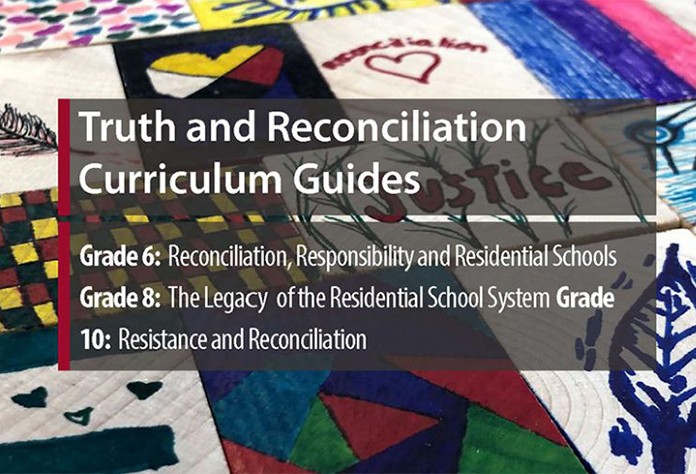The Legacy of the Residential School System in Canada
In this unit, through group discussions, personal reflections and engaging activities, students are involved in thinking about all six of the Historical Thinking Concepts. For instance, in lesson three, students are engaging with multiple historical thinking concepts through a stations activity. By exploring a variety of sources, including primary source evidence, students are discussing, through question prompts, about the historical significance, historical perspective, cause and consequence, and ethical dimensions of the treatment of Indigenous individuals in the Cecilia Jeffrey Residential School. In lesson five, students are learning about resistance to government imposed legislation from Indigenous groups in the past and in the present, thus engaging with continuity and change. They are also engaging with historical significance as they think about the importance of the preservation of Canada’s Indigenous cultures and research Indigenous culture revitalization efforts.
The Cecilia Jeffrey Indian Residential School opened in 1902 and closed in 1976 (TRC, 2015, Honouring the truth). Originally located on the Shoal Lake Reserve (Manitoba), it moved to Kenora (Ontario) in 1929 to accommodate more students (Pomeroy, 2010). It is most known as the school Chanie Wenjack, a 12 year old boy from Ogoki Post on the Marten Falls Reserve, escaped from (Adams, 1967).
The student population of Cecilia Jeffrey were the young residents of the surrounding area of Shoal Lake (part of Anishinaabe Nation Treaty #3). The Residential School System had the goal of assimilating future generations of Indigenous youth into the presumed “assumption that European civilization and Christian religions were superior” to Indigenous cultures (TRC, 2015, What we have learned, p. 7). Children who attended Cecilia Jeffrey would live at the school, away from their families and their cultures, and would be subject to lessons and work to upkeep the school building. At the school, many children were subjected to physical, emotional and sexual abuse, inadequate nutrition, experiments and illness.
The school was operated by the Presbyterian Church. The Church was responsible for the operation of the school while the government funded the school and provided the policies under which the school was meant to operate (The Presbyterian Church in Canada Archives, 2011, p.6). The funding the school received was based on a per capita grant, which meant that a certain amount of money was provided for each student at the school. This funding was intended to cover items like food, clothing, school and building supplies, salaries of teachers and general maintenance needs of the school buildings (The Presbyterian Church in Canada Archives, 2011, p.6).
In 1957, the government took on a larger role in funding the school and moved away from their per capita approach and funded the schools based on actual expenses (Presbyterian Church in Canada Archives, 2011, p. 7). In 1969, the operation of the Cecilia Jeffrey Residential School was transferred to the Federal Government of Canada, and remained in the government’s control until its closure in 1974 (The Presbyterian Church in Canada Archives, 2011, p. 9). In this case study, it was the Presbyterian Church who ran Cecilia Jeffrey, but all across Canada, “Roman Catholic, Anglican, United, Methodist, and Presbyterian churches were the major denominations involved in the administration of the residential school system” (TRC, 2015, What we have learned, p.6). These institutions, along with the Canadian Federal Government, were responsible for an estimated “150,000” Indigenous youth who attended residential schools (TRC, 2015, What we have learned, p. 6). It is noted in the TRC reports that “ the government’s partnership with the churches remained in place until 1969, and, although most of the schools had closed by the 1980s, the last federally supported residential schools remained in operation until the late 1990s” (p. 6).
Until the 1940s, students who attended Cecilia Jeffrey Residential School were on a “half-day” system. They would learn in a classroom for half of the day, and the other half was meant for vocational training. For boys, this meant working on the farm and school grounds, and for the girls, it usually meant learning how to sew and cook (The Presbyterian Church in Canada Archives, 2011, p.7). After the 1940s, students had a full day of in-class learning. Students who completed Grade 8 were eligible to take an entrance exam to attend a high school in Kenora. The percentage of students entering high school from Cecilia Jeffrey was extremely small. In 1949, 300 students attended Cecilia Jeffrey, while only 17 of these were in high school (The Presbyterian Church in Canada Archives, 2011, p. 8).
Christian education was an important element of the daily lessons. Attending worship services, scripture readings and exercises were a part of their daily routine (The Presbyterian Church in Canada Archives, 2011, p. 8).
For children, life in these schools was lonely and alien. Buildings were poorly located, poorly built, and poorly maintained. The staff was limited in numbers, often poorly trained, and not adequately supervised. Many schools were poorly heated and poorly ventilated, and the diet was meagre and of poor quality. Discipline was harsh, and daily life was highly regimented. [Indigenous] languages and cultures were demeaned and suppressed. The educational goals of the schools were limited and confused, and usually reflected a low regard for the intellectual capabilities of Aboriginal people. For the students, education and technical training too often gave way to the drudgery of doing the chores necessary to make the schools self-sustaining. Child neglect was institutionalized, and the lack of supervision created situations where students were prey to sexual and physical abusers. The Presbyterian Church has acknowledge their complicity in these horrendous acts. (TRC, 2015, What we have learned, p.7)
The Residential School System has profound and devastating eff ects on Indigenous Peoples today. This is reflected in the
...significant disparities in education, income, and health between [Indigenous Peoples] and other Canadians—disparities that condemn many [Indigenous Peoples] to shorter, poorer, and more troubled lives” (TRC, 2015, What we have learned, p.103). It is noted in the TRC final reports that “the legacy [of the Indian Residential School System] is also reflected in the intense racism and the systemic discrimination [Indigenous] people regularly experience in this country” (TRC, 2015, What we have learned, 103). Moreover in terms of language, “more than a century of cultural genocide has left most [Indigenous] languages on the verge of extinction” TRC, 2015 (What we have learned, p.103). The impacts of Indian Residential Schools continue to reverberate today with the of the way Indigenous children were treated in residential schools can also be felt today with “the disproportionate apprehension of [Indigenous] children by child-welfare agencies and the disproportionate imprisonment and victimization of [Indigenous] people. (TRC, 2015, What we have learned, p.103).
During the TRC hearings it was also reported:
Many students [are] permanently damaged by residential schools. Separated from their parents, they grew up knowing neither respect nor affection. A school system that mocked and suppressed their families’ cultures and traditions destroyed their sense of self-worth and attachment to their own families. Poorly trained teachers working with an irrelevant curriculum left them feeling branded as failures. Children who had been bullied and physically or sexually abused [carry] a burden of shame and anger for the rest of their lives. Overwhelmed by this legacy, many succumbed to despair and depression. Countless lives were lost to alcohol and drugs. Families were destroyed, and generations of children have been lost to child welfare. The Survivors are not the only ones whose lives have been disrupted and scarred by the residential schools. The legacy ... also profoundly [affects] the Survivors’ partners, their children, their grandchildren, their extended families, and their communities. Children who were abused in the schools sometimes went on to abuse others. Some students developed addictions as a means of coping. Students who were treated and punished as prisoners in the schools sometimes graduated to real prisons. The Commission recognizes that these impacts cannot be attributed solely to residential schooling. But they are clearly attributable to the Aboriginal policies of the federal government over the last 150 years. (TRC, 2015, What we have learned, p.103)
Many of these assimilationist policies are maintained today through the Indian Act.




